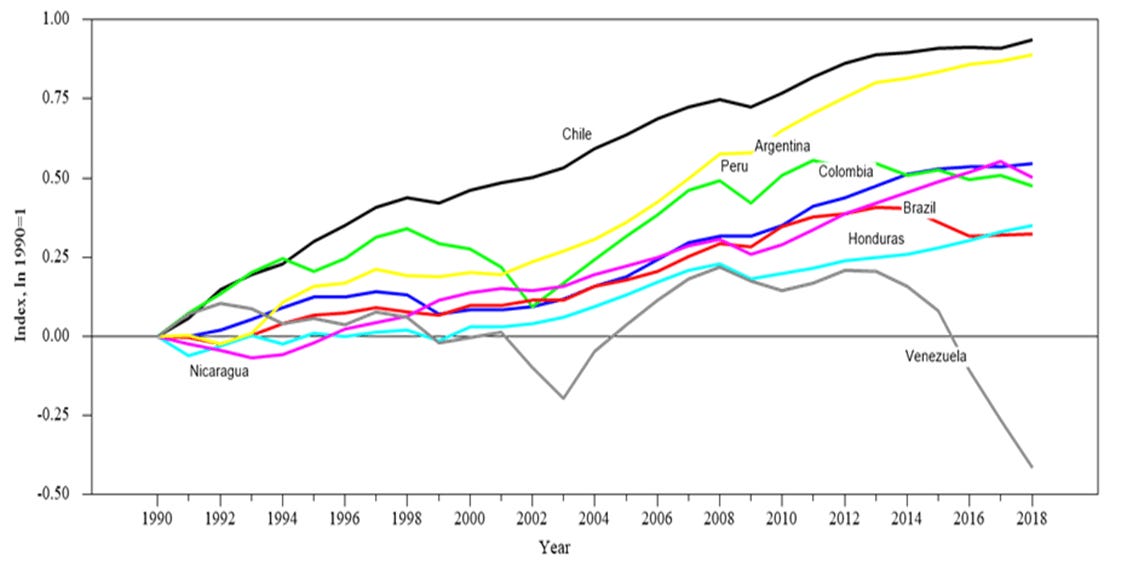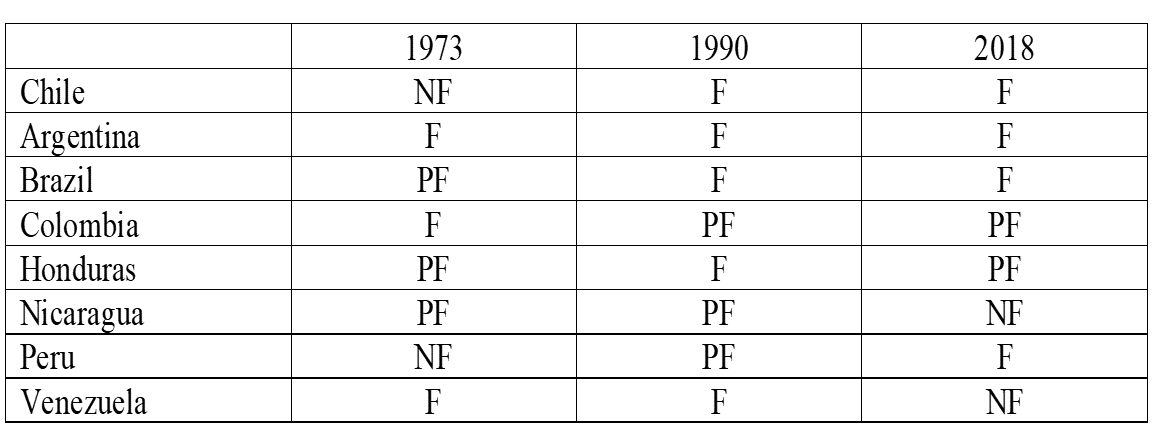Maybe Chile isn’t so bad after all
Spoiler. The current demonstrations and riots in Chile that started as protests against a 3.75% increase in public transportation tariffs. The focus of the demonstrations seems to have turned into demands of a fairer society. The protests may be justified. And the rage over military forces patrolling the streets, reminding people about Pinochet’s brutal regime is understandable. But contrary to what we read and hear from the often-ill-informed media, and what Leftists want us to believe, the people of Chile are not subject to oppression and impoverishment by neo-liberal policies. In fact, if one looks at Chile over time, incomes have increased, and inequality decreased.
I must admit that I’m confused when it comes to the developments in Chile. The media appears to be equally confused. Demonstrations against a public transportation tariff increase turned into riots. That seems to be clear. But some media report that the tariff was a demand from the IMF while other tell me that it was not even a decision but determined by an autonomous technical board. According to Swedish Radio, the focus of the demonstrations has now changed focus and concern the very high inequality in Chile. An inequality which has increased over time. Unfortunately, Swedish Radio did not tell me whether it was income inequality, wealth inequality, or perhaps inequality in access to education and health. Having heard the programme, I also wondered about poverty. Are many people poor? Is poverty increasing or decreasing? And so on.
Swedish Radio may be right in their reporting, but it may also be true that at the same time the people in Chile never have enjoyed more freedom and prosperity than they do today. Let’s have a look! I will also compare Chile with seven other countries in the region. The governments of these countries cover the full political spectrum from left to right and there are variations also within some countries, as Chile, over time.
Beginning with prosperity, GDP per capita in Chile has on average grown by 3.4% year since 1990. Another fast grower is Peru while Venezuela is a disaster, c.f. Figure 1.
Figure 1. GDP per capita in Chile and other Latin-American countries 1990-2018.
Source: World Bank Database. World Development Indicators. Note: All series are shown as logs of an index, which equals 1.0 at 1990 so the series start at zero. Since the vertical axis is in log units, the slopes of the series are growth rates. An increase of 0.1 is a growth of 100*(exp(0.1)-1).
Next stop inequality and poverty. I couldn’t find data on wealth inequality, so I’ll have to do with income inequality. It turns out that inequality and poverty are relatively high in Latin America and inequality in Chile is also high but poverty in Chile is very low, c.f. Table 1.
Table 1. Inequality and poverty in Chile and other Latin-American countries.
Source: World Bank Database. Note: Poverty gap at $5.50 a day (2011 PPP) (% of population). 2017 data except for Nicaragua, 2014 and Venezuela, 2006.
And, contrary to what Swedish Radio tells us, inequality has decreased since the end of Pinochet, or at least since 1994. The same with poverty. Only two percent of the population was considered to be poor in 2017. That is a decrease from 14%, a seventh of the population, in 1994, c.f. Figure 2.
Figure 2. Inequality and poverty in Chile 1994 – 2017.
Source: World Bank Database. Note: Poverty gap at $5.50 a day (2011 PPP) (% of population).
Nor did the Swedish Radio tell us anything about the progress made in the population’s health over time. Life expectancy and neonatal mortality rates have decreased in Chile as well as in other countries. An interesting, and probably annoying fact, for Leftists that that not only is life expectancy almost constant in Venezuela, but also has the neonatal mortality rate increased during Maduro, c.f. Figure 3.
Figure 3. Life expectancy (left) and neonatal mortality (right) in Chile and other Latin-American countries.
Source: World Bank Database. Note: Neonatal mortality rate is the number of neonates dying before reaching 28 days of age, per 1,000 live births in a given year.
What about freedom and civil rights? Chile became a democracy again after Pinochet’s reign which lasted until 1988 when he lost a national referendum denying him another eight-year term as president. The Pinochet regime which was extremely brutal in the beginning after the coup in 1973 did gradually permit more freedom of assembly, speech and association including trade unions and political parties. According to Freedom House, Chile became a democracy in 1990 and was classified as Free by Freedom House, c.f. Table 2.
Table 2. Freedom status in Chile and other Latin-American countries 1973, 1990 and 2018.
Source: Freedom House: www.freedomhouse.org Note: F is free, PF partly free and NF not free.
The military coup 1976 that turned Argentina to a brutal dictatorship does not show up in the table above. Chile kept is status as Free ever since 1990 and Chile was the only country which Freedom House considered to have a free press in its 2017 report, c.f. Table 3.
Table 3. Freedom of the Press status in Chile and other Latin-American countries 1990 and 2017.
Source: Freedom House: www.freedomhouse.org Note: F is free, PF partly free and NF not free.
But the brutal attacks of police and the military on the demonstrators are not reconcilable with a society characterised by democracy and rule of law. There are also reasons to criticise the judicial system which gives military courts the jurisdiction over human rights abuses by law enforcement institutions.
This leads one to wonder about the quality of institutions in Chile. Countries that are characterised as free, have in general stronger institution than countries where freedom of expression and press is under pressure from the authorities. According to the World Bank’s analysis, institutions in Chile are considerably stronger than in the other countries, c.f. Figure 4.
Figure 4. Control of corruption and Rule of Law in Chile and other Latin-American countries in 2017.
Source: World Bank Database. https://databank.worldbank.org/data/source/worldwide-governance-indicators#
Although that looks relatively good, the people in Chile are not satisfied just because the people in Venezuela is living in hell. And the people in Chile have reason to be concerned. The quality of institutions in Chile have deteriorated since 2011. Both indicators range from -2.5 to +2.5. Since 2011, Control of corruption has decreased from 1.58 to 1.04 and Rule of law from 1.39 to 1.01 which tells me that there is ground for discontent with the government in Chile.
And there are more causes for discontent among Chileans. According to the World Bank, the educational and health care systems need substantial reforms to ensure that the whole population have access to basic education and health care. Chiliean spending on education and health does not impact inequality as much as it does in European countries. Furhtermore, public spending on education and health care is not sufficient as Chile’s private spending on health care and education is relatively much greater than in most OECD countries. Since labour income is the major income source, inequality in access to education is a major determinant of income inequality in Chile. Similarly, there are also variations across the socio-economic groups w.r.t. to access to health care, c.f. Figure 5.
Figure 5. Equality in access to education and health in Chile 1990-2018.
Source: V-Dem. Varieties of Democracy. https://www.v-dem.net/en/ Note: Equality in education in health ranges from 0 to 4 where indicates extremely unequal distributions and 4 equal distributions of basic education and healthcare.
So, it turns out that two seemingly opposing views of Chile are correct. The first is that demonstrations today against an inequal society demanding fairer eduacational and health care systems are justified. The second is that people in Chile today enjoy more freedom, are healthier and more prosperous than ever before in the history of Chile. And to that we could add that Chileans are better off than their neighbours which shows up in a higher highest Human Development Index than its neighbours, c.f. Figure 6.
Figure 6. Human Development Index 2017 for Chile and other Latin-American countries.
Source. UnitedNationshttp://hdr.undp.org/en/2018-update
Read and find out more:
Human Rights Watch: https://www.hrw.org/
OECD: http://www.oecd.org/chile/
The Quality of Government institute: https://qog.pol.gu.se/
Varieties of Democracy: https://www.v-dem.net/en/
World Bank https://www.worldbank.org/en/country/chile
World Bank (2017) Chile - Systematic Country Diagnostic: Transitioning to a Prosperous Society. Washington, D.C.: World Bank Group.












